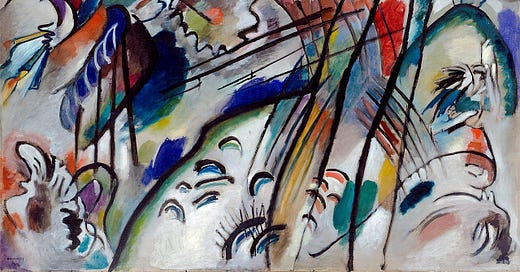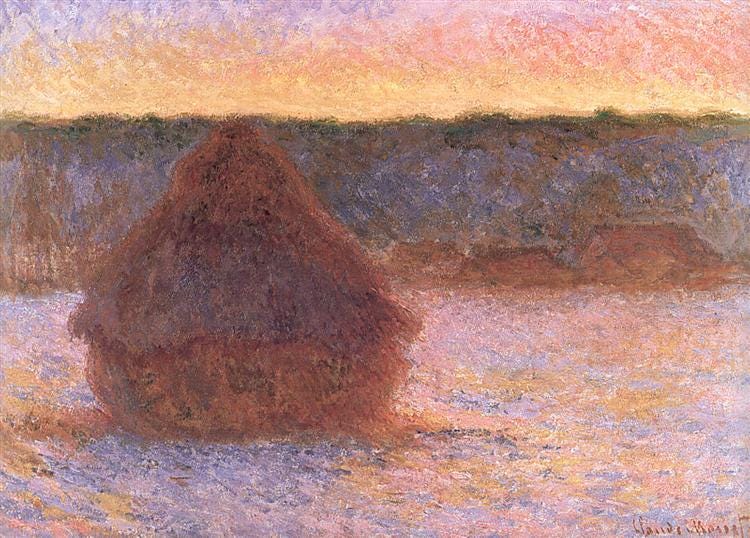Vasily Kandinsky’s Improvisation 28 (Second Version) is in the Guggenheim in New York. He painted it in 1912.
Kandinsky created abstract, nonobjective art, meaning his paintings are not representative of anything found in the world around you/do not take form from the visible world. With his images, and nonobjective art in general, it’s instinctual to try to define it or relate it to something we recognize from the world around us. Instead, though, Kandinsky strives to use painting not as a narrative medium, but an emotional medium. He was inspired originally by seeing Monet’s Haystacks paintings:
These Impressionist paintings work towards the same thing - not creating a narrative but creating a feeling. They are giving you the *impression* of that moment in time. Kandinsky said about a haystacks painting:
“That it was a haystack the catalogue informed me. I could not recognise it. This non-recognition was painful to me. I considered that the painter had no right to paint indistinctly. I dully felt that the object of the painting was missing. And I noticed with surprise and confusion that the picture not only gripped me, but impressed itself ineradicably on my memory. Painting took on a fairy-tale power and splendour.”
Not fully grasping the exact object (the haystack) to his experience of that object in his lived experience made the painting much more impactful on him emotionally. Kandinsky took that concept into his own art, using even more abstraction to affect viewers on an emotional level directly through the painting, rather than through a recognizable narrative that would affect them because of a past understanding they brought to the interaction with the painting.
Improvisation 28 (Second Version) is one of those paintings Kandinsky created that aims to use color as “a means of exerting direct influence upon the soul.” It shows a lot of intense, very strong/saturated colors. It’s a chaotic, busy painting. Further to his goal of evoking emotions through nonrepresentational means, Kandinsky looked to music as an equivalent art form that did this too.
He saw a direct and clear relationship between music and art, using paint to represent music. Kandinsky spoke a lot to synesthesia, the phenomenon where people experience colors when they listen to music, taste when seeing certain words, etc. He would listen to music while painting, and let it come through in his art. Many of his works were titled using musical terms (composition, improvisation, etc.).
Kandinsky’s art, and his writing about art, was important to the canon and specifically influential for American Abstract Expressionism, who used a lot of his ideas to influence emotions directly through their nonobjective art. He’s a great example of how your interaction with a painting doesn’t necessarily need to be related to understanding its history or style - your experience can valuable and impactful for you regardless of how much or how little you know!
More learning:
Smarthistory has a great video/transcript speaking about this painting in the Guggenheim!




